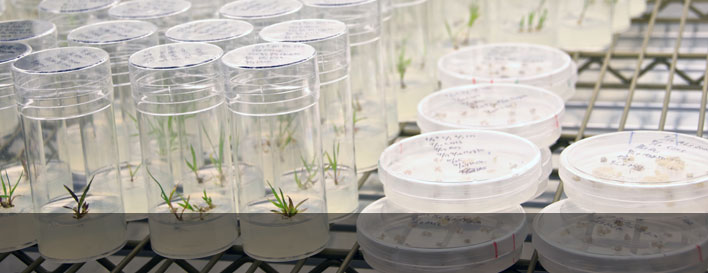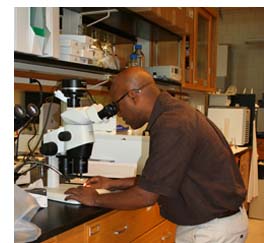Dr. Million Tadege


“Since switchgrass is one of the dedicated biofuel crops and it’s a widely grown native grass in Oklahoma, we will be tasked in convincing farmers to cultivate switchgrass when the time is right.”
 Dr. Tadege's research focuses on understanding the molecular basis of total biomass production by dissecting key developmental programs that control plant size and architecture. His program specifically focuses on identifying genes and genetic pathways that control leaf development, plant height and floral transition in C4 grasses; primarily sorghum and switchgrass. The aim is to identify key genes that can be used in the breeding programs of sorghum and switchgrass to enhance biomass feedstock development for lignocellulosic biofuel production. He and his co-researchers are also developing a deletion-based functional genomics resource in sorghum to facilitate systems level understanding of plant development in C4 grasses.
Dr. Tadege's research focuses on understanding the molecular basis of total biomass production by dissecting key developmental programs that control plant size and architecture. His program specifically focuses on identifying genes and genetic pathways that control leaf development, plant height and floral transition in C4 grasses; primarily sorghum and switchgrass. The aim is to identify key genes that can be used in the breeding programs of sorghum and switchgrass to enhance biomass feedstock development for lignocellulosic biofuel production. He and his co-researchers are also developing a deletion-based functional genomics resource in sorghum to facilitate systems level understanding of plant development in C4 grasses.
Researcher Seeks to Crack Leaf Lamina Development Code
The leaves of plants are “the best solar panels ever built.” Why, you ask? Because, the leaves of plants are where carbon dioxide from the atmosphere and light energy from the sun are used to produce sugars, which has rightfully given leaves their claim to fame.
With this in mind, Million Tadege, assistant professor of plant functional genomics in the department of plant and soil sciences at Oklahoma State University, has invested most of his research time into a leaf lamina development project.
Tadege hopes to create optimal plant leaf mass so the OSU bioenergy research team can increase the amount of useable material for biofuels.
“From a structural point of view, broader leaves with a more planar surface area improve photosynthetic efficiency by allowing more efficient capture of solar energy and promoting gas exchange,” said Tadege. “However, such leaves would lose water rapidly, resulting in poor water use efficiency under dry conditions.”
Plants in a more moist environment may have broad and flat leaves to maximize photosynthesis, while plants that have adapted to the arid areas may produce small, thick leaves and grow slowly to avoid dehydration.
C4 plants including sorghum and switchgrass are more efficient in photosynthesis under high irradiance and high heat conditions and have a better water use efficiency in arid and semi arid environments attributing to the unique ability of their leaves to combine large surface area for carbon fixation to limited water loss by transpiration.
Such a strategy is what confers high biomass production capacity to most biofuels crops including switchgrass, biomass sorghum, energy cane and Miscanthus. Leaves are, therefore, the most important biomass determinant organs with adaptive ecological significance.
“We set out to understand the mechanism of leaf lamina development by identifying the key genetic factors and uncovering their mode of actions. The genes we are currently characterizing can be directly used for engineering crops to boost productivity or can be used as molecular markers to incorporate high biomass yielding traits in economically important biofuel crops such as switchgrass and sorghum,” Tadege said. “The implication is that this project will help farmers in Oklahoma and other parts of the nation to produce more biomass for lignocellulosic biofuels from a limited land area.”
This reduces the competition of fuel crops with food crops for fertile land on one hand and promotes bioenergy sustainability on the other hand.
“The latter is critical for energy security of this nation and reduction of environmental pollution to preserve the habitability of our plant for future generations,” he said.
Pictured (above): Dr. Million Tadege works in his Oklahoma State University lab.
Hao Lin | Postdoctoral Fellow | China | [email protected]
Lifang Niu | Postdoctoral Fellow | China | [email protected]
Tezera Wolabu Watira | Doctoral Student | Ethiopia | [email protected]
Hui Ling Yeang | Masters Student | Malaysia | [email protected]
Bold items indicate OK EPSCoR-supported research
- Tadege M., H. Lin, M. Bedair, A. Berbel, J. Wen, C. M. Rojas, L. Niu, Y. Tang, L.1 Sumner, P. Ratet, N. A. McHale, F. Madueño, and K. S. Mysore. “STENOFOLIA Regulates Blade Outgrowth and Leaf Vascular Patterning in Medicago truncatula and Nicotiana sylvestris.” Plant Cell. (2011). doi: 10.1105/tpc.111.085340.
Access the publication
- Zhou C., L. Han, C. Hou, A. Metelli, L. Qi, M. Tadege, K. S. Mysore, and Z. Y. Wang. “Developmental Analyses of a Medicago Truncatula Mutant Smooth Leaf Margin1 Reveal Distinct Ontogenies Among Plant Organs.” Plant Cell. (2011). doi:10.1105/tpc.111.085464.
Access the publication
- Laurie R. E., P. Diwadkar, M. Jaudal, L. Zhang, V. Hecht, J. Wen, M. Tadege, K. S. Mysore, J. Putterill, J. L. Weller, C. Richard, and R. C. Macknight. “The Medicago truncatula FLOWERING LOCUS T Homologue, MtFTa1, is a Key Regulator of Flowering Time.” Plant Physiology. (2011). doi:10.1104/pp.111.180182.
Access the publication
- Chen J., J. Yu, L. Ge, H. Wang, A. Berbel, Y. Liu, Y. Chen, G. Li, M. Tadege M, J. Wen, V. Cosson, K. S. Mysore, P. Ratet, F. Madueño, G. Bai, and R. Chen. “Control of Dissected Leaf Morphology by a Cys(2)His(2) Zinc Finger Transcription Factor in the Model Legume Medicago truncatula.” Proceedings of the National Academy of Sciences U. S. A. (2010). 107: 10754-10759.
Access the publication
- Tadege M., T. L. Wang, K. Wen, P. Ratet, and K. S. Mysore. “Mutagenesis and Beyond! Tools for Understanding Legume Biology.” Plant Physiology. (2009). 151: 978-984. doi: 10.1104/pp.109.144097.
Access the publication
- Tadege M., J. Wen, J. He, H. Tu, Y. Kwak, H. Tu, A. Eschstruth, G. Endre, P. Zhao, M. Chabaud, P. Ratet, and K. S. Mysore. “Large Scale Insertional Mutagenesis Using the Tnt1 Retrotransposon in the Model Legume Medicago truncatula.” Plant Journal. (2008). 54: 335-347. doi: 10.1111/j.1365-313X.2008.03418.x.
Access the publication
- Trevaskis B., M. Tadege, M. Hemming, W. J. Peacock, E. S. Dennis, and C. Sheldon. “SVP-like MADS-box Genes Inhibit Floral Meristem Identity in Barley.” Plant Physiology. (2007). 143: 225-235.
Access the publication
- Tadege M., P. Ratet, and K. S. Mysore. “Insertional Mutagenesis: a Swiss Army Knife for Functional Genomics of Medicago truncatula.” Trends in Plant Science. (2005). 10: 229-235.
Access the publication
- Tadege M., C. C. Sheldon, C. A. Helliwell, N. Updaha, E. S. Dennis, and W. J. Peacock. “Reciprocal Control of Flowering Time by OsSOC1 in Transgenic Arabidopsis and by FLC in Transgenic Rice.” Plant Biotechnology Journal. (2003). 1:361-369.
Access the publication
- Tadege M., C. C. Sheldon, C. A. Helliwell, P. Stoutjesdijk, E. S. Dennis, and W. J. Peacock. “Control of Flowering Time by FLC Orthologues in Brassica Napus.” Plant Journal. (2001). 28: 545-553 (cover).
Access the publication
Biomass Functional Genomics by Million Tadege
A presentation in the OK EPSCoR Biofuels Teleconference Series
